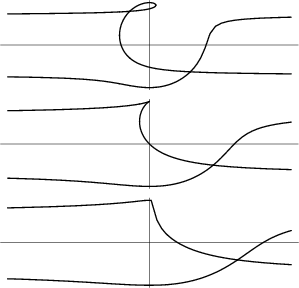|
|
|

These curves appear in Dürer's work Instruction in Measurement with Compasses and Straight Edge (1525) and arose in
investigations of perspective. Dürer constructed the curve by drawing lines ![]() and
and ![]() of length 16 units through
of length 16 units through
![]() and
and ![]() , where
, where ![]() . The locus of
. The locus of ![]() and
and ![]() is the curve, although Dürer found only one of the two
branches of the curve.
is the curve, although Dürer found only one of the two
branches of the curve.
The Envelope of the lines ![]() and
and ![]() is a Parabola, and the curve is therefore
a Glissette of a point on a line segment sliding between a Parabola and one of its Tangents.
is a Parabola, and the curve is therefore
a Glissette of a point on a line segment sliding between a Parabola and one of its Tangents.
Dürer called the curve ``Muschellini,'' which means Conchoid. However, it is not a true Conchoid and so is sometimes called Dürer's Shell Curve. The Cartesian equation is
References
Lawrence, J. D. A Catalog of Special Plane Curves. New York: Dover, pp. 157-159, 1972.
Lockwood, E. H. A Book of Curves. Cambridge, England: Cambridge University Press, p. 163, 1967.
MacTutor History of Mathematics Archive. ``Dürer's Shell Curves.''
http://www-groups.dcs.st-and.ac.uk/~history/Curves/Durers.html.